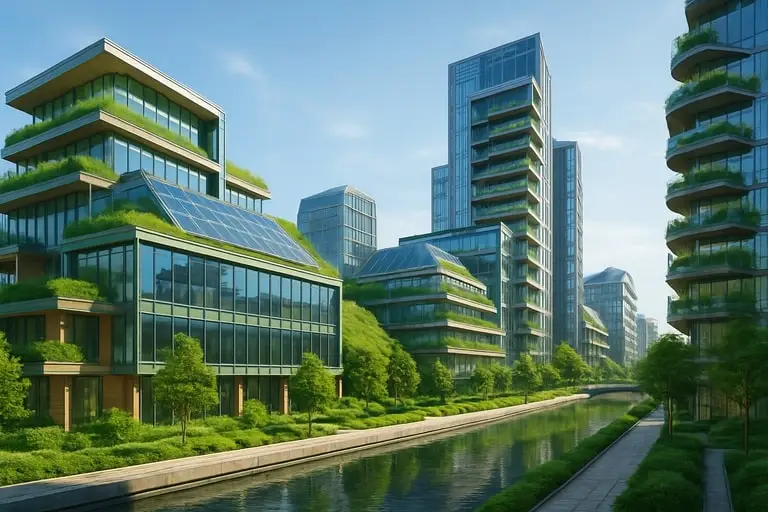Modern architecture design represents more than a stylistic choice; it reflects a deliberate shift in how societies build, inhabit, and perceive space in relation to cultural identity and environmental responsibility. The discipline no longer limits itself to aesthetic gestures but instead incorporates scientific insight, sustainable engineering, and advanced technology into every phase of development. Architects work closely with urban planners and engineers to create spaces that address rapid population growth, environmental pressures, and the demand for livable, resilient environments. These collaborations allow for a seamless blending of function and form, where each structure tells a story of human adaptation to modern challenges while still respecting timeless principles of proportion, harmony, and order.
In recent decades, modern architecture design has embraced materials and methods that prioritize sustainability and longevity. Glass façades, once criticized for inefficiency, now integrate with smart shading systems and energy-efficient glazing, ensuring comfort without waste. Concrete, steel, and timber are reimagined through low-carbon alternatives and hybrid structural systems, minimizing environmental footprints while maximizing durability. What emerges is a vocabulary of construction that merges science and art, rooted in a responsibility to build not just for today but for generations ahead.
At the core of this evolution lies a profound respect for ecological systems. Modern architecture design does not isolate buildings from their surroundings but seeks integration with natural landscapes, daylight patterns, and airflow strategies. Designers deploy passive cooling, natural ventilation, and green roofs to reduce dependency on mechanical systems. This approach nurtures an organic bond between human activity and the biosphere, fostering an architectural ethos that feels less like domination and more like dialogue with the environment.
The social dimension of modern architecture design is equally significant. Cities across the globe recognize that design quality impacts public health, productivity, and social interaction. When architects prioritize natural light, spatial flexibility, and inclusive access, the built environment becomes a catalyst for community well-being. Schools, offices, and cultural centers designed with these principles cultivate belonging and productivity, elevating human experience while responding to cultural diversity.
Technology amplifies these ambitions through innovations such as parametric modeling, digital fabrication, and intelligent building systems. Modern architecture design thrives on these tools, enabling precision in construction and adaptability in performance. Smart sensors adjust lighting and temperature dynamically, while building information modeling allows architects and engineers to forecast maintenance, energy use, and environmental impact decades into the future. These advancements extend architecture’s responsibility beyond design toward stewardship of entire life cycles.
In global cities, modern architecture design becomes a marker of identity. Iconic towers, museums, and civic centers serve as cultural landmarks, projecting both local heritage and contemporary innovation. Yet beyond signature projects, smaller residential and community developments also embody these principles, ensuring that the benefits of thoughtful design are not limited to elite spaces but distributed across everyday life. This democratization of quality aligns architecture with social equity, an increasingly urgent dimension of sustainable futures.
Critics often warn against excess symbolism or reliance on spectacle in modern architecture design, noting risks of alienation or cultural disconnection. However, the best examples achieve equilibrium: they push aesthetic boundaries while retaining human scale, embedding technology while nurturing community, and embracing globalization while preserving authenticity. This delicate balance defines the credibility and legacy of the discipline in the twenty-first century.
Ultimately, modern architecture design is a testament to the human capacity for reinvention. It invites us to imagine cities as ecosystems where buildings are active participants in energy cycles, cultural exchange, and social life. In this light, every structure becomes more than shelter—it becomes a narrative of resilience, creativity, and collective aspiration toward sustainable futures.
Modern architecture design and evolving concepts
Modern architecture design and its evolving concepts are inseparable from the cultural and technological revolutions shaping contemporary society. Architecture modern design continues to challenge conventions by blending innovation with responsibility, recognizing that each building is both an artistic statement and a living system. Architects now operate with heightened awareness of climate challenges, global migration, and digital transformation, weaving these factors into spatial solutions that respond dynamically to shifting realities. Such awareness elevates the practice from static construction to adaptive evolution, ensuring longevity in a rapidly changing world.
A key driver of transformation lies in the integration of sustainable construction practices. Environmental impact, once considered secondary, is now central to project briefs, influencing choices in material sourcing, energy systems, and waste management. Through advanced modeling and renewable energy integration, modern architecture design and evolving concepts create buildings that generate power, capture water, and purify air. This regenerative mindset surpasses the minimalism of efficiency, striving instead to leave a positive ecological legacy that inspires confidence in sustainable futures.
Urbanization amplifies the urgency of these approaches. As cities swell with millions of new residents, modern architecture design must accommodate density without compromising dignity. Compact yet flexible housing typologies, mixed-use developments, and transit-oriented layouts offer pathways to resilient urban growth. These models prioritize walkability, reduce car dependency, and cultivate vibrant public spaces, making urban life not only sustainable but also enjoyable. In this context, architecture modern design functions as a mediator between personal privacy and collective vitality.
Cultural narratives underpin these evolutions. Every society interprets modern architecture design through its unique heritage, adapting global trends to local traditions. In Japan, minimalism coexists with technology; in Scandinavia, wood construction blends with social egalitarianism; in Latin America, vibrancy and communal living inform architectural expression. These variations remind us that evolving concepts are not universal blueprints but diverse translations of shared aspirations. Such pluralism enriches the global conversation, allowing architecture to remain inclusive and authentic.
Advancements in digital tools redefine the architect’s role. Computational design allows exploration of complex geometries, once unbuildable, while artificial intelligence aids decision-making across structural analysis and energy optimization. Virtual reality enables clients and communities to inhabit spaces before construction, shaping dialogue and reducing conflict. These technologies empower architects to push the limits of creativity while remaining grounded in data and practicality, bridging artistry with measurable performance.
Societal demands further stretch the scope of modern architecture design. Inclusivity now means designing for neurodiverse individuals, children, and the elderly alongside traditional accessibility needs. Safety, resilience, and adaptability are paramount as natural disasters intensify. Buildings no longer succeed solely by standing tall but by providing refuge, connection, and long-term adaptability to crises. This holistic vision positions architecture not as luxury but as essential infrastructure for thriving societies.
The aesthetic language of modern architecture design continues to evolve, balancing minimalism with expressive form. Clean lines and open spaces coexist with bold curves and experimental façades, reflecting diversity of cultural outlooks and technological capacity. This visual dynamism communicates progress while maintaining a sense of timelessness, ensuring relevance across decades. Through this aesthetic dialogue, buildings become both art and shelter, symbolic and functional.
Modern architecture design and its evolving concepts reveal that architecture is a living discipline, constantly negotiating between permanence and impermanence, tradition and innovation, locality and globalization. Each project becomes part of a larger narrative of human ambition and environmental responsibility, underscoring that the future of construction lies not in repeating formulas but in constantly reshaping them to meet the demands of our age.
Modern architecture design and sustainable construction
Modern architecture design and sustainable construction are bound together by necessity, shaping how the built environment responds to climate, resource scarcity, and human well-being. The fusion of contemporary buildings with ecological imperatives demonstrates that architecture is not merely an artistic expression but a strategic instrument for planetary survival. Designers increasingly see each project as an opportunity to restore balance, where the built form serves both human aspirations and environmental integrity.
The pursuit of sustainability requires deep rethinking of traditional practices. Green roofs, solar panels, and water harvesting systems become integral rather than decorative, transforming buildings into active participants in environmental cycles. Modern architecture design and sustainable construction embrace lifecycle assessments, ensuring that carbon costs, maintenance demands, and eventual deconstruction are accounted for from the outset. This holistic perspective prevents waste, encourages innovation, and sets measurable benchmarks for progress.
Community impact is at the center of sustainable construction. Projects are judged not only by their carbon footprint but also by their ability to nurture human connections. Shared spaces, adaptable layouts, and integration with public transit encourage healthier lifestyles and stronger communities. By aligning social and ecological goals, modern architecture design demonstrates that sustainability is not a constraint but a catalyst for enriching urban life.
Economic considerations reinforce this shift. Although initial investments in sustainable technologies may appear high, long-term benefits in energy savings, maintenance reduction, and resilience justify the cost. Forward-thinking developers and policymakers recognize that sustainable construction is not a luxury but a financial imperative. Buildings designed with durability and adaptability in mind attract tenants, foster trust, and enhance reputations. These outcomes validate the philosophy that ecological responsibility aligns seamlessly with economic rationality.
Cultural acceptance of sustainable construction also continues to grow. Modern architecture design communicates ecological values through visible features—green façades, natural materials, daylight-filled interiors—that resonate with public consciousness. These visual cues build awareness and normalize environmentally responsible choices, embedding sustainability into daily experience. Architecture thus becomes a medium of education and advocacy, shaping cultural expectations and inspiring future generations to demand more from their environments.
Technology magnifies these possibilities. Advanced sensors, renewable energy integration, and modular construction accelerate the adoption of sustainable principles. Digital twins allow predictive maintenance and resource tracking, reducing inefficiency and extending building lifespans. With these tools, modern architecture design and sustainable construction form a feedback loop of continuous improvement, where data informs better design and performance metrics validate innovation.
Global collaboration enhances progress. Knowledge exchange between countries accelerates adoption of best practices, whether it involves bamboo construction in Asia, passive houses in Europe, or urban greening in North America. By learning from diverse contexts, modern architecture design ensures that sustainable construction evolves with flexibility and inclusivity. Such global dialogue underscores the universality of environmental responsibility, even as solutions remain locally tailored.
Ultimately, modern architecture design and sustainable construction highlight humanity’s capacity to confront existential challenges with creativity, intelligence, and empathy. Each building conceived with these principles becomes a declaration of hope, signaling that progress does not require environmental sacrifice but can instead flourish through harmony. As architects, planners, and communities embrace this vision, the built environment transforms into a living testimony of resilience and stewardship.
Contemporary buildings symbolize the constant dialogue between culture, technology, and human need, embodying the architectural spirit of our age. They are not defined solely by style but by their responsiveness to context, sustainability, and functionality. Unlike traditional monuments that sought permanence, contemporary buildings embrace adaptability, reflecting the fluid nature of modern life. Their glass façades, sculptural forms, and innovative layouts are more than visual statements—they are solutions to pressing challenges such as urban density, climate change, and resource scarcity. As cities grow and societies diversify, the architecture of today carries the responsibility of creating environments that are both inspiring and practical, leaving behind structures that speak to the values of an era rooted in innovation and awareness.
One of the most defining characteristics of contemporary buildings is their focus on sustainability. Architects and engineers no longer treat energy efficiency as an optional feature but as a fundamental criterion of design. Green roofs, solar panels, natural ventilation systems, and rainwater harvesting techniques are seamlessly integrated into projects.
These technologies transform buildings from passive consumers of energy into active participants in environmental cycles. By embedding ecological systems within urban fabric, contemporary buildings highlight that sustainability is not an aesthetic trend but an essential dimension of resilience and responsible growth. The resulting structures become long-term assets that minimize carbon footprints and reduce maintenance costs while enhancing occupant comfort and well-being.
Technology also plays a central role in shaping contemporary buildings, redefining what is possible in both form and function. Digital modeling tools, artificial intelligence, and advanced fabrication techniques allow architects to explore geometries and materials that were once unthinkable. Parametric design, for example, enables the creation of façades that respond dynamically to light and climate, ensuring performance alongside beauty.
Prefabrication and modular construction speed up timelines and reduce waste, offering practical solutions to the demands of expanding cities. Inside, smart systems monitor energy use, adjust lighting, and maintain indoor air quality, ensuring that buildings remain efficient and adaptable long after they are completed. In this sense, technology does not simply serve design but becomes its foundation, pushing the boundaries of possibility while anchoring projects in measurable outcomes.
The social dimension of contemporary buildings is equally profound, for architecture today is deeply tied to human experience. Gone are the days when imposing forms sufficed; instead, projects now emphasize inclusivity, accessibility, and community engagement. Public plazas, flexible interiors, and mixed-use programs bring people together, fostering interaction and connection in spaces once dominated by separation.
Schools designed with open learning environments, hospitals that prioritize natural light and healing gardens, and offices that encourage collaboration all demonstrate how architecture can elevate daily life. By placing human well-being at the center, contemporary buildings redefine success not by their height or grandeur but by the quality of experience they deliver to the people who use them.
Globalization influences this evolution by blending local traditions with international innovation. Contemporary buildings in Tokyo might reinterpret traditional wooden construction with modern materials, while projects in Mexico City celebrate vibrant colors and communal courtyards with contemporary efficiency. In Scandinavian nations, designers emphasize wood and natural landscapes, embedding social equity into spatial planning.
This cultural pluralism ensures that contemporary buildings are not generic reproductions but tailored responses to unique contexts. The best examples balance global influence with local authenticity, producing architecture that resonates universally while remaining rooted in place. Such hybridity reinforces the idea that architecture is a living dialogue, continuously adapting to the interconnected world we inhabit.
Economics further shapes contemporary buildings, as developers, investors, and governments increasingly recognize the financial value of well-designed spaces. Sustainable features may increase upfront costs, but they deliver long-term returns through lower operational expenses and higher market appeal. Residential towers with integrated amenities, energy-efficient office complexes, and adaptive reuse of historic structures attract tenants and buyers who value both function and meaning.
As property markets evolve, architecture that prioritizes durability and adaptability gains competitive advantage, proving that design excellence is inseparable from financial strategy. Thus, contemporary buildings become investments not only in real estate but in the future viability of cities.
The aesthetics of contemporary buildings vary widely, reflecting the freedom and diversity of our era. Minimalist lines coexist with daring, expressive forms, while natural materials meet high-tech composites in creative fusion. Architects no longer adhere rigidly to one style but instead compose hybrids that respond to program, site, and culture.
Transparency, fluidity, and openness often dominate visual language, symbolizing values of communication and progress. Yet aesthetics are not detached from ethics: the choice of materials, visibility of ecological systems, and attention to human scale all inform the appearance of contemporary buildings. This synthesis ensures that beauty is not ornamental but purposeful, reinforcing architecture’s broader mission.
Urban resilience is another lens through which contemporary buildings must be evaluated. In an age of climate uncertainty, architects design for floods, heat waves, and earthquakes, ensuring that structures protect lives while minimizing disruption. Elevated foundations, adaptable façades, and shock-absorbing technologies embody resilience, proving that architecture is not static but responsive.
Furthermore, cities integrate networks of contemporary buildings into larger systems of green infrastructure, transit hubs, and digital grids, creating an ecosystem of interdependence. Each project thus becomes part of a broader effort to ensure urban environments are not only habitable but capable of thriving under pressure.
Ultimately, contemporary buildings tell a story of human ingenuity and aspiration. They are the physical manifestation of societies that demand sustainability, embrace technology, and value inclusivity. Far from being cold abstractions, these projects are alive with meaning, anchoring communities, inspiring creativity, and shaping cultural identity.
They remind us that architecture is not just about structures but about the lives lived within and around them. In embracing responsibility alongside creativity, contemporary buildings mark a turning point in history: a time when the built environment reflects not just where we are but where we aim to go. They stand as monuments not to power or permanence but to vision, resilience, and the enduring human desire to create places of significance.
Design in modern architecture is not just a matter of aesthetics; it is the core philosophy that shapes how humans interact with their environments. Architects today approach projects with the understanding that every line, material, and proportion has meaning far beyond its immediate appearance.
This philosophy emphasizes the relationship between people and the spaces they inhabit, ensuring that each structure is both visually striking and functionally sound. By integrating sustainability, technology, and cultural context, design in modern architecture has evolved into a discipline that seeks to balance beauty with purpose, creating spaces that resonate with the spirit of contemporary society.
At the heart of design in modern architecture lies sustainability. Where earlier eras of construction often prioritized spectacle or monumental scale, the present moment demands ecological responsibility. Architects now select materials that reduce carbon footprints, integrate renewable energy systems, and embrace passive climate strategies that make buildings more energy-efficient.
Green roofs, solar panels, and water conservation measures have moved from experimental concepts to standard features. This transformation underscores that sustainability is not an afterthought but an intrinsic component of the design process. By embedding environmental values into every stage of planning, design in modern architecture ensures long-term resilience for cities and communities.
Technology plays a decisive role in pushing the boundaries of what design in modern architecture can achieve. Computational tools, artificial intelligence, and digital modeling allow architects to envision geometries that once seemed impossible. Building Information Modeling (BIM) has become a cornerstone of the profession, enabling collaboration between engineers, contractors, and designers at unprecedented levels of precision.
Façades can now respond to shifting sunlight, interior systems adjust automatically to occupancy levels, and structural components are optimized for strength with minimal material waste. This union of creativity and technology demonstrates how design in modern architecture embodies the forward-thinking ethos of our age.
Human experience remains central to the success of design in modern architecture. Beyond technological feats and sustainability metrics, the ultimate goal of architecture is to enrich the daily lives of individuals. Natural light, accessible layouts, and inclusive spaces shape environments that encourage well-being and productivity.
Schools designed with flexible learning zones, offices with collaborative work hubs, and healthcare facilities that emphasize healing atmospheres all illustrate how design can influence behavior and emotions. When architecture succeeds in aligning space with human need, it transcends utility to become a force for social progress.
Cultural context also defines design in modern architecture, ensuring that global innovation adapts to local traditions. A project in Dubai may embrace futuristic skyscrapers with bold façades, while a residential complex in Copenhagen emphasizes wood, transparency, and community living.
In India, courtyards and shaded passages inspired by traditional forms integrate seamlessly with contemporary methods. These diverse expressions reveal that design in modern architecture is not a uniform style but a global language spoken in countless dialects. This adaptability affirms architecture’s relevance in a world where cultural identity remains as significant as technological advancement.
The economic implications of design in modern architecture cannot be underestimated. Developers, governments, and investors increasingly recognize that well-designed structures attract tenants, increase property value, and reduce operational costs. Sustainable strategies may involve higher upfront spending, but their long-term returns—through energy savings, lower maintenance, and improved resilience—justify the investment.
Furthermore, iconic and intelligently designed projects become symbols of civic pride, enhancing reputations and encouraging tourism. This alignment between design excellence and financial logic strengthens the case for treating architecture not as an expense but as a long-term asset.
Visually, design in modern architecture balances minimalism with bold expression. Some projects employ clean lines and open spaces that emphasize clarity, while others experiment with dramatic curves, asymmetrical façades, or innovative use of materials. Transparency, openness, and fluid transitions between indoors and outdoors reflect the values of connectivity and progress.
Yet even the most daring visual choices are guided by purpose, ensuring that aesthetics never overshadow functionality. This harmony between form and intention exemplifies the maturity of contemporary architectural practice, where every choice is deliberate and meaningful.
Resilience has become another defining aspect of design in modern architecture. Buildings are increasingly engineered to withstand natural disasters, fluctuating climates, and evolving social demands. Flood-resistant foundations, earthquake-proof structures, and adaptive layouts ensure that architecture protects and empowers communities in uncertain times.
As cities face rising sea levels, heat waves, and rapid migration, resilience shifts from being an optional consideration to a central tenet of design. The ability of architecture to endure change while remaining relevant is a powerful reminder that design is about more than shelter—it is about safeguarding the future.
Ultimately, design in modern architecture reflects the aspirations and responsibilities of humanity in the twenty-first century. It is a field where art meets science, where beauty is inseparable from performance, and where global challenges inspire innovative solutions.
Each project becomes a statement about who we are and where we are headed: a testament to creativity, resilience, and collective progress. By integrating sustainability, technology, human-centered planning, cultural awareness, and economic foresight, design in modern architecture establishes itself not only as a profession but as a transformative force shaping the destiny of societies worldwide.













